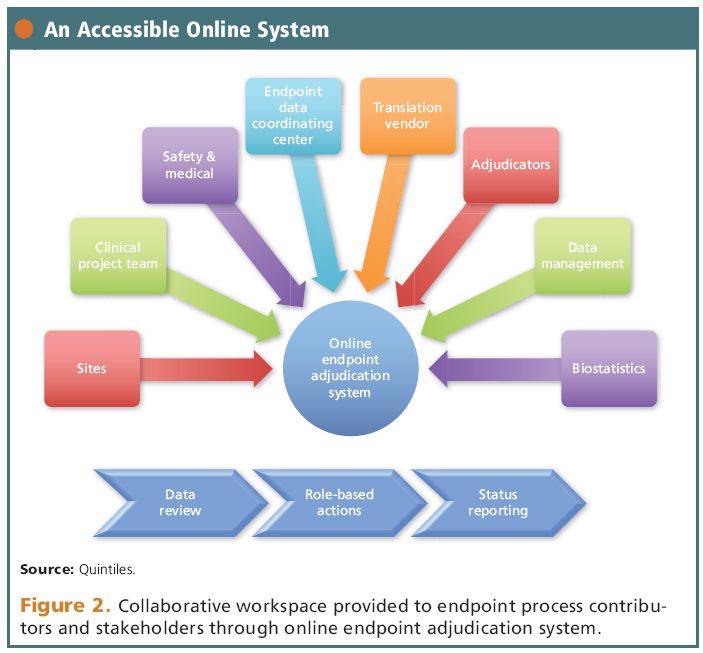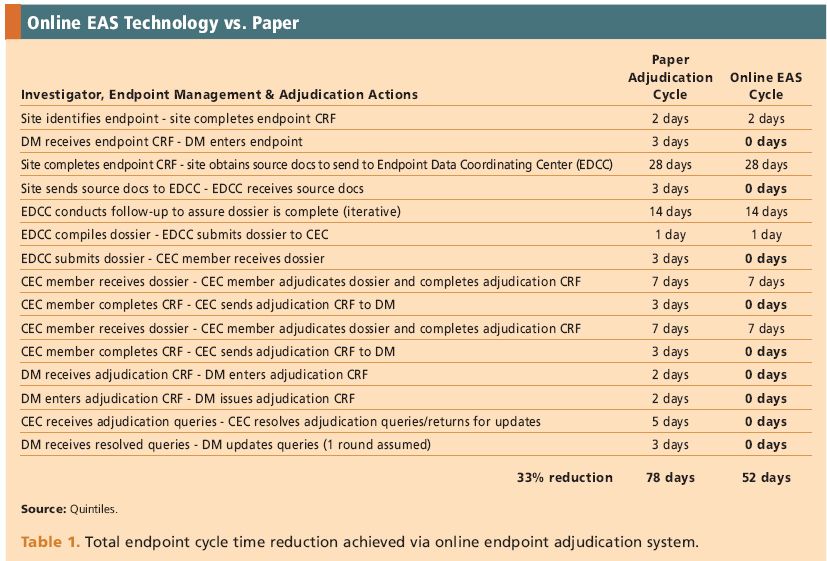Electronic Endpoint Adjudication
Applied Clinical Trials Supplements
How an integrated, EDC-based system can optimize the endpoint process.
Biopharmaceutical and medical device companies have made EDC (electronic data capture) a cornerstone of clinical trial and registry management because of its proven, significant process improvements over paper-based systems.

EDC is a technology that allows sponsors to conduct clinical trials and registries electronically, instead of using outmoded paper processes. EDC has shown tangible efficiency gains in data capture across the board, including dramatic efficiencies in large trials with many patients, locations, and data points. EDC simplifies and accelerates the clinical trial data collection, cleaning, and management process by organizing and storing data in a secure, central database.
Role of clinical endpoint committees
A Clinical Endpoint Committee (CEC) is a panel of unbiased, third-party experts charged with centrally reviewing and classifying suspected endpoints, ascertaining whether they meet protocol definitions, and providing standardized endpoint outcomes for the purposes of statistical analysis. CECs review and adjudicate endpoint-specific data, applying complex medical definitions to determine these outcomes.
Information reviewed by the CEC for each endpoint is primarily based on source documentation from the patient chart, including documents such as: Admission History & Physical, Discharge Summary, progress notes, medication administration records, procedure reports, lab reports, radiology reports, consultation notes, medical imaging data (e.g., chest x-rays, angiograms, echocardiograms, ultrasounds, MRIs), data from external devices (e.g., pacemakers), and autopsy reports.
It is through review of this kind of descriptive chart documentation that CEC adjudicators are able to independently and critically assess the circumstances surrounding the suspected endpoint, so that they can produce a medically precise adjudicated outcome.
The use of CECs to adjudicate suspected endpoints has increased considerably over the past 10 years. CEC-adjudicated endpoint outcomes can figure prominently in a number of key clinical trial decision-making processes: power calculations, periodic safety reviews by Data Safety Monitoring Boards, sample-size reestimation and other interim analyses, next stage progress for adaptive design trials, study completion for event-driven trials, and overall results for efficacy and safety analyses.
Implementation of a CEC requires cross-functional planning with respect to study timelines, budget, and quality management; a well-defined integrated data capture strategy for effective endpoint case management; and a CEC adjudication process that is structured to deliver consistent, reliable, and accurate results.
With the increasing focus on proactive management of product benefit–risk balance and the prominence with which endpoint data factor into this equation, it is imperative to minimize any impact of process-driven variability on endpoint outcomes. The process controls and data integrations offered by online Endpoint Adjudication System (EAS) technology contribute to meeting this objective by enabling project teams to achieve new levels of standardization and consistency, by enhancing the timeliness and quality of endpoint data capture, and by facilitating more rapid and robust decision-making.
Online endpoint management & adjudication
One of the most important clinical trial capabilities made possible by EDC is online adjudication to support the CEC endpoint adjudication process. Until recently, online adjudication was often omitted from the EDC workflow because it required features and performance that were not available in existing platforms. But now it is a vital component of EDC, successfully implemented in tens of thousands of cases in trials across a range of indications.
Use of online EAS technology enables implementation of an end-to-end, transparent endpoint workflow, which creates significant cost efficiencies and measurably reduces cycle times by offering a collaborative workspace for all relevant stakeholders to contribute to the endpoint process, by partially automating the process steps with a flexible electronic workflow, and by integrating all components of the endpoint management and adjudication workflows into a single, seamless system, which is imbedded within an EDC platform.
Benefits of an online system
A major benefit of performing all related endpoint process steps within an EDC platform that includes an online EAS, is that each essential process component is linked into an overall integrated system process map. This eliminates manual handoffs, reduces reconciliations, and facilitates paperless document collection, data integrations, and real-time information exchange. The process components of an integrated EDC endpoint workflow begin with eCRF endpoint reporting, and move through electronic source document and medical image collection, case review and processing, translation of non-English source documents, electronic dossier compilation, and paperless submission of endpoint dossiers to CEC adjudicators. CEC adjudicators then conduct an online dossier review and provide their adjudicated outcomes via eCRF (see Figure 1).

Endpoint workflows are dynamic and interactive, with multiple steps and dataflows, contributors and stakeholders. As a result, project teams, endpoint data coordinating centers, and CECs need endpoint data and documents to be centrally accessible in a collaborative workspace, where data and document exchange activities are optimized.
Online EAS technology provides an integrated environment with role-based activities across multiple parties and a cohesive workflow that can be configured to drive both standard and custom models for endpoint data collection and information exchange.
Online EAS technology also creates a collaborative workflow that includes sites, the clinical project team, safety and medical personnel, the endpoint data coordinating center, the translation vendor, adjudicators, data and project managers, and biostatisticians. Stakeholders can access the system to perform data review, complete role-based actions, and review standard, customized, and user-empowered status reports (see Figure 2).

Since final adjudicated outcomes must be available rapidly for a number of key decision-making purposes, the endpoint adjudication process is always on the critical path. Online EAS technology can achieve significant reductions in overall endpoint cycle times, shortening the time from endpoint report to final adjudication by a third of the total duration typically observed with a paper-based process (see Table 1). Use of online EAS technology also brings a number of logistical and financial benefits to projects and programs with endpoint management. From a labor standpoint, this approach eliminates paper from the workflow, removes a number of paper-based steps, partially automates a number of remaining steps, and reduces the volume of data and statuses that need to be tracked manually. This approach also lowers project costs by eliminating courier and fax charges, which have traditionally been required to transport paper documents from sites to endpoint coordinating centers to CEC adjudicators. In addition, this approach reduces, and in some cases eliminates, travel costs, which have traditionally been required for regular face-to-face CEC adjudication meetings.

Creating value
Incorporating all endpoint-related data capture and workflows into an EDC-based platform makes the endpoint reporting, endpoint management, and CEC adjudication processes fast, convenient, cohesive, and cost-efficient, with a consistent and high-quality result.
Investigators appreciate the user friendliness of the Endpoint Reporting eCRF format, which is a feature of online EAS technology. The system allows sites to use the same eCRF page to complete data fields and attach supporting source document files for suspected endpoints. The design of the eCRF also guides users through a logic tree, so that it is easy for the site to determine what is needed for each type of suspected endpoint that has been identified.
Online EAS technology extends the advantages of EDC for clinical data collection. For example, the system can collect eCRF data and store source documents in any file format. This includes advanced functionality for collection, storage, and annotation of even the most complex documents—medical image data. As a result, online EAS technology streamlines and speeds the endpoint data coordination workflow.
Online EAS technology provides flexible, easily configurable workflow options to support all of the different CEC adjudication models that are in use. There are options for batched endpoint submissions, as well as real-time case-by-case submissions. In addition, it is not necessary for CEC adjudicators to log in to check whether there are cases or queries to address, because the system notifies them via an email alert if they have a new action to take. And these alerts can be grouped at any frequency to prevent item-by-item notifications.
Online EAS technology offers full-scale technical infrastructure support, including a 24x7 Help Desk to support system users, on-demand video training, and on-screen CRF completion guidelines to assist all system users with data capture. The system also includes a project library, including: online posting of system user manuals, trial protocols, CEC charters, and endpoint definitions.
While online EAS technology is configured as a component of a specific EDC platform and is ideally suited for implementation end-to-end within a single environment, the technology can be used as a standalone system, and it can successfully interface in a modular fashion through integration with other EDC platforms as well—as long as proper measures are put in place to control for the impacts of a multiple system environment on stakeholders such as sites, monitors, and data managers (e.g., through clearly delineating the data capture purpose within each system and automating data exchange between systems to minimize or eliminate data reconciliations). This versatility enables the benefits offered by online EAS technology to be realized across a wide number of settings.
Conclusion
The advent of EDC-based, integrated online EAS technology, as a complete approach to clinical asset management, delivers quantifiable improvements and value across virtually every aspect of the endpoint process and fully incorporates it into the overall clinical trial process. The distinct advantages of this approach begin with ease of use and flexibility. Significant gains are achieved from shorter cycle times and notable project cost savings. In addition, there is a marked increase in quality by enabling comprehensive review of all necessary documentation for adjudication, by enabling early detection and resolution of discrepancies, and by contributing significantly to overall process standardization and compliance. The result is a thorough, well-governed process that operates in real-time, achieving rapid delivery of robust adjudicated endpoint outcomes for critical project-level and product-level decision-making.
Considering the extensive benefits it has to offer, it's clear that online EAS technology is an excellent response to the new clinical, regulatory, and business challenges faced by the biopharmaceutical and medical device industries.
Cathy Tyner , MA, MFA, ABD, is Senior Director & Global Unit Head, Clinical Safety & Endpoint Management Solutions, Lifecycle Safety, for Quintiles, Inc. Zaher El-Assi* is Senior Director, Global Sales & Strategic Partnerships, at KIKA Clinical Solutions, email: [email protected]. Cathy and Zaher have been working in collaboration for the past three years to bring joint value to the successful set up and delivery of endpoint adjudication programs through alignment of expertise in endpoint management operations with innovation in clinical system solutions. The resulting online EAS platform has been presented to major biotechnology and pharmaceutical companies that have embraced the value, and utilization is rapidly gaining momentum.
*To whom all correspondence should be addressed.
